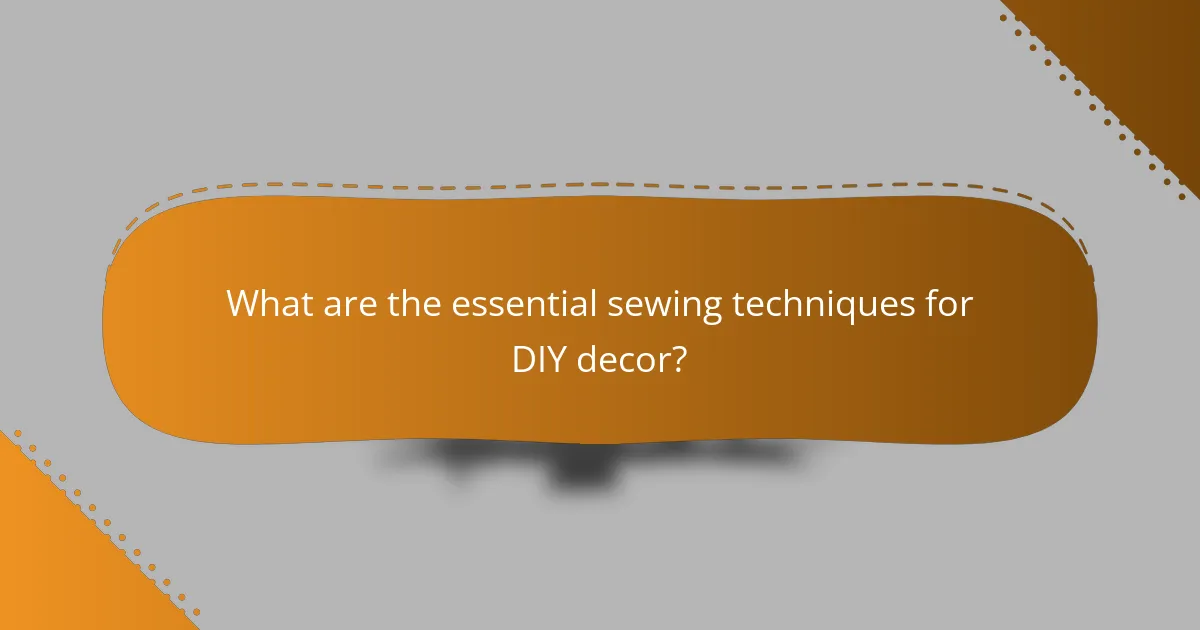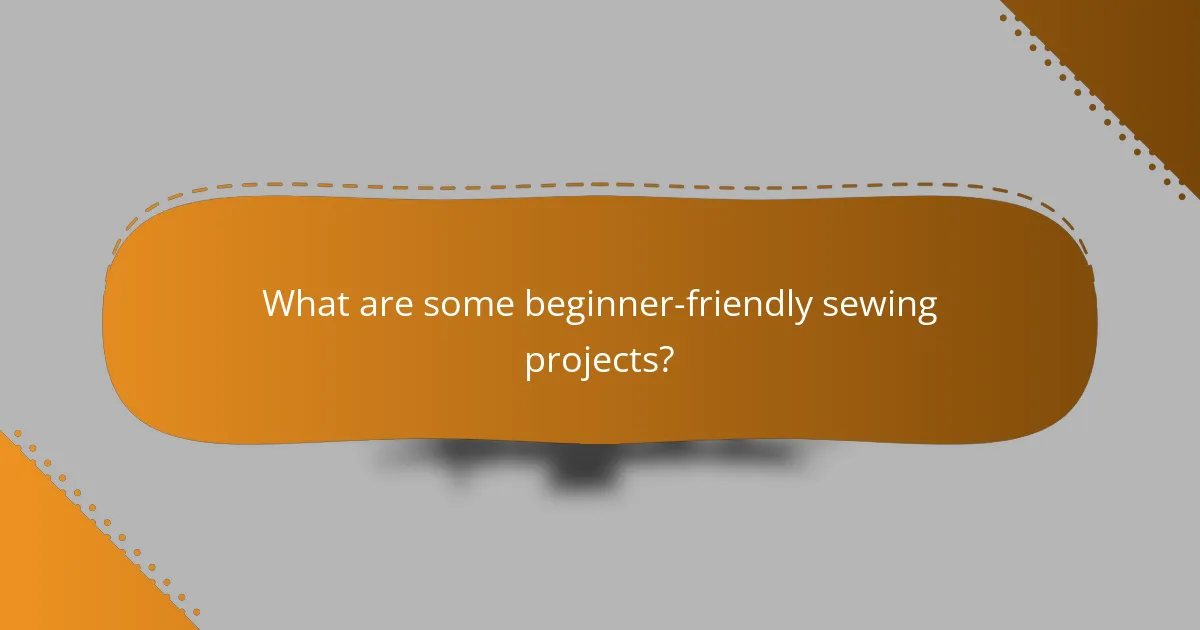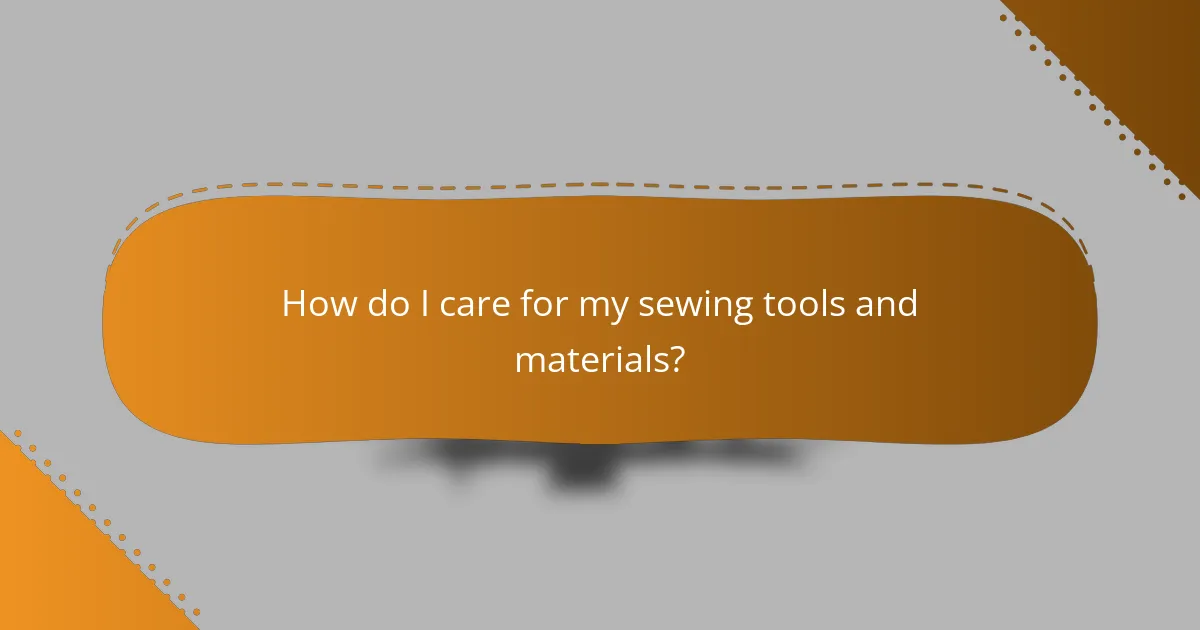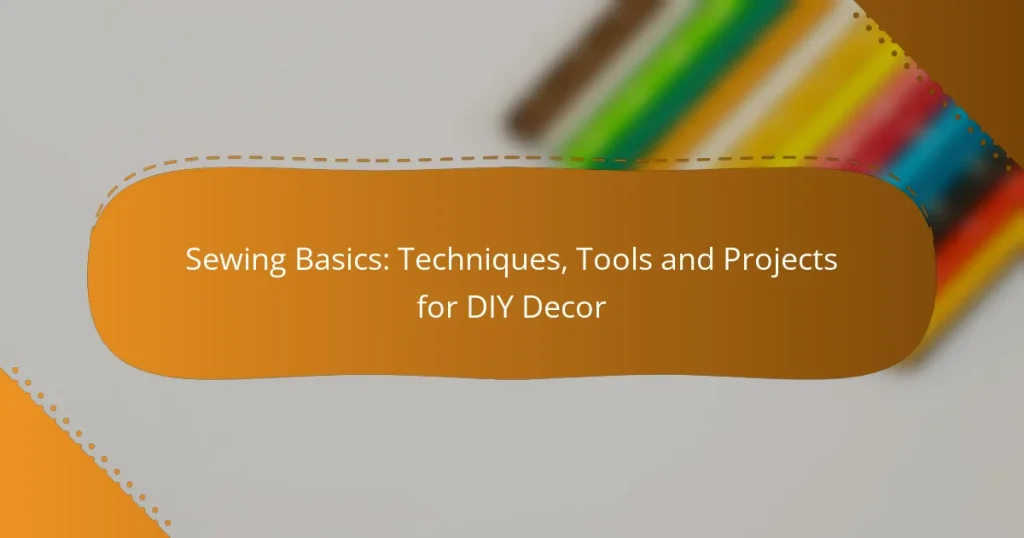Embarking on DIY decor projects through sewing can transform your living space with personalized touches. By mastering essential techniques and utilizing the right tools, you can create beautiful items like curtains and cushions that reflect your unique style. Selecting the appropriate fabrics is crucial, as it ensures both aesthetic appeal and durability for your creations.

What are the essential sewing techniques for DIY decor?
The essential sewing techniques for DIY decor include basic stitching, seam construction, edge finishing, hand sewing, and machine sewing. Mastering these skills allows you to create a variety of decorative items, from curtains to cushions, enhancing your home with personalized touches.
Basic stitching techniques
Basic stitching techniques form the foundation of sewing for DIY decor. The most common stitches include straight stitch, zigzag stitch, and backstitch. Each serves different purposes, such as securing fabric edges or creating decorative patterns.
For beginners, practicing straight stitches on scrap fabric can build confidence. Aim for even spacing and consistent tension to achieve a polished look in your projects.
How to sew seams
Sewing seams is crucial for joining fabric pieces in your decor projects. The most common seam type is the plain seam, where two fabric edges are aligned and stitched together. Ensure that you use a seam allowance of about 1/4 to 1/2 inch, depending on the project requirements.
Pressing seams open after sewing helps reduce bulk and creates a neater finish. For added durability, consider using a zigzag stitch along the raw edges to prevent fraying.
Finishing edges with serging
Finishing edges with serging prevents fabric from fraying and gives a professional look to your DIY decor items. A serger machine trims the fabric while simultaneously stitching the edges, creating a clean finish. This technique is particularly useful for lightweight fabrics that tend to unravel easily.
If you don’t have a serger, you can use a zigzag stitch on a regular sewing machine as an alternative. Just ensure to set the stitch width and length appropriately to cover the raw edges effectively.
Hand sewing techniques
Hand sewing techniques are valuable for small repairs and detailed work in DIY decor. Techniques such as whip stitch and slip stitch can be used for hemming or attaching embellishments. Hand sewing allows for greater control and precision, especially in intricate areas.
Keep a needle and thread handy for quick fixes or adjustments. When sewing by hand, use a thimble to protect your fingers and ensure even stitches.
Using a sewing machine
Using a sewing machine streamlines the sewing process and is essential for larger projects. Familiarize yourself with the machine’s settings, including stitch types and tension adjustments, to achieve the best results. Start with simple projects like pillow covers to build your skills.
Always test your stitches on scrap fabric before starting your main project. This practice helps you adjust settings and ensures you’re comfortable with the machine’s operation, reducing the likelihood of mistakes.

What tools do I need for sewing projects?
To successfully complete sewing projects, you need a variety of essential tools that enhance your efficiency and accuracy. These tools range from basic hand tools to more advanced machines, each serving a specific purpose in the sewing process.
Essential sewing tools
Essential sewing tools include items like needles, thread, pins, and a seam ripper. Needles come in various sizes and types, so choosing the right one for your fabric is crucial. A good pair of fabric scissors is also necessary for clean cuts, while pins help hold fabric pieces together during sewing.
Additionally, a sewing gauge can assist with measuring hems and seam allowances accurately. Investing in quality tools will improve your sewing experience and the final outcome of your projects.
Recommended sewing machines
When selecting a sewing machine, consider your skill level and the types of projects you plan to undertake. Beginners may benefit from a simple, user-friendly model with basic stitches, while more experienced sewists might prefer machines with advanced features like automatic buttonholes or embroidery capabilities.
Popular brands such as Brother, Singer, and Janome offer a range of machines suitable for different budgets, typically starting from around $100 for basic models to over $1,000 for high-end options. Always check for warranty and customer support when making a purchase.
Fabric scissors and rotary cutters
Fabric scissors are specifically designed for cutting fabric and should be kept sharp to ensure clean edges. Avoid using them on paper or other materials to maintain their effectiveness. A good pair of fabric scissors can cost between $20 and $50, depending on the brand and quality.
Rotary cutters are another option, especially useful for cutting multiple layers of fabric or intricate shapes. They work best with a cutting mat and can provide more precision than scissors. Ensure you use a self-healing mat to prolong the life of both your cutter and the mat.
Measuring tools and rulers
Accurate measurements are vital in sewing, making measuring tools indispensable. A flexible measuring tape is essential for taking body measurements and fabric lengths, while a clear quilting ruler helps with straight cuts and precise angles.
Consider using a seam gauge for smaller measurements, particularly for hems and seam allowances. These tools typically range from $5 to $20, making them affordable investments for any sewing kit.
Notions for sewing
Notions are the small items that assist in the sewing process, including buttons, zippers, and interfacing. When choosing notions, consider the fabric type and the intended use of your project. For example, heavier fabrics may require sturdier zippers and interfacing.
Keep a well-stocked supply of common notions on hand, as they can vary in price significantly, from a few cents for buttons to several dollars for specialty items. Organizing these supplies in a dedicated container can streamline your sewing process and help you avoid last-minute trips to the store.

How can I choose fabrics for DIY decor?
Choosing fabrics for DIY decor involves considering the intended use, aesthetics, and durability. Look for materials that complement your design vision while also being practical for your space.
Types of fabrics for home decor
Common fabric types for home decor include cotton, linen, polyester, and velvet. Cotton is versatile and easy to clean, making it great for upholstery and curtains. Linen offers a natural, textured look, while polyester is durable and often more affordable.
Velvet adds a luxurious touch but may require more maintenance. For outdoor decor, consider fabrics like acrylic or solution-dyed polyester, which resist fading and moisture.
Fabric weight and drape considerations
Fabric weight affects how a material hangs and behaves in a space. Lightweight fabrics, such as sheer cotton, are ideal for flowing curtains, while heavier fabrics like canvas are better for structured items like cushions or upholstery.
Consider the drape of the fabric as well; fabrics with a soft drape, like rayon, create a relaxed look, while stiffer materials maintain their shape. Aim for a balance that suits your design intent.
Color and pattern selection tips
When selecting colors and patterns, consider the overall color scheme of your room. Neutral colors can create a calming effect, while bold patterns can serve as focal points. Use color swatches to visualize how fabrics will look in your space.
Mixing patterns can add interest, but aim for a cohesive look by varying the scale of patterns—pair large prints with smaller ones. Keep in mind that lighter colors can make a space feel larger, while darker shades can create warmth and intimacy.

What are some beginner-friendly sewing projects?
Beginner-friendly sewing projects are simple and quick to complete, making them ideal for those new to sewing. These projects often require minimal materials and basic techniques, allowing novices to build confidence and skills.
Pillow covers
Pillow covers are an excellent starting point for beginners. They typically involve straight seams and can be customized with various fabrics and patterns. To make a basic pillow cover, measure your pillow, cut two fabric pieces slightly larger than the pillow dimensions, and sew them together, leaving an opening for inserting the pillow.
Consider using cotton fabric for ease of handling and washing. A simple envelope closure can eliminate the need for zippers, making the process even easier.
Table runners
Creating a table runner is another straightforward project that adds a decorative touch to your dining area. Start by measuring your table’s length and width, then cut a piece of fabric that is about twice the width and the same length as the table. This allows for a nice drape.
For added flair, you can use contrasting fabrics for the front and back or add embellishments like lace or trim. Ensure to finish the edges with a straight stitch or zigzag to prevent fraying.
Simple curtains
Simple curtains can enhance any room and are easy to sew. Measure your window and decide on the desired length and width of the curtains. Cut the fabric accordingly, allowing extra for hems and seams.
To create a basic rod pocket, fold over the top edge of the fabric and sew a straight line, leaving enough space for the curtain rod. Use lightweight fabric for a breezy feel or heavier fabric for more privacy.
Fabric baskets
Fabric baskets are practical and versatile, perfect for organizing items around the home. Start by cutting two rectangles of fabric for the outer and lining layers. Sew the outer fabric pieces together, then repeat for the lining, leaving an opening in the lining for turning.
After turning the outer fabric right side out, insert it into the lining, and sew the top edges together. You can add interfacing for sturdiness and personalize the baskets with different fabrics or embellishments.

How do I care for my sewing tools and materials?
Caring for your sewing tools and materials involves regular cleaning, proper storage, and routine maintenance to ensure longevity and optimal performance. By following specific guidelines for each tool and material, you can prevent damage and enhance your sewing experience.
Cleaning and maintaining sewing machines
Regular cleaning and maintenance of your sewing machine are crucial for its performance and longevity. Start by unplugging the machine and removing any dust and lint from the bobbin area and feed dogs using a soft brush or a vacuum attachment designed for small spaces.
Additionally, oil your machine according to the manufacturer’s instructions, typically every few months or after extensive use. Use only the recommended sewing machine oil, as other types can cause damage. Regularly check and replace the needle, as a dull or bent needle can lead to skipped stitches and fabric snags.
To avoid common pitfalls, always keep your sewing machine covered when not in use to prevent dust accumulation. Schedule a professional servicing annually if you sew frequently, as this can help identify and fix issues before they escalate.


